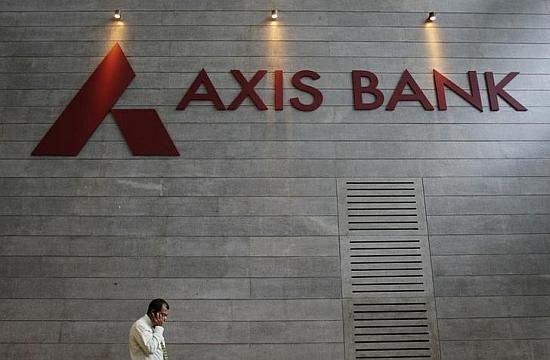Under Sharma Axis Bank has also taken the lead in focusing on technology, which has now become core to almost every other lender's strategy, says Nupur Anand.

When Shikha Sharma took the elevator to the corner office at Axis Bank in April 2009, the view outside must have been hazy.
In the aftermath of the Lehman crisis, global growth was on the decline and stock markets had nosedived.
The view inside the country's third largest bank wasn't very clear either: Sharma stepped into the shoes of PJ Nayak, who had quit the chairmanship prematurely, after pitching for an internal candidate as managing director and CEO instead of hoisting an outsider. There was obviously heartburn among a section of employees at the decision to appoint her to the top job.
The challenging times that Sharma faced in handling a new organisation only increased a year and a half down the line, when the bank decided to acquire Enam Securities.
This deal came at a time when the stock markets were not doing particularly well, earning her the ire of the investor community.

However, five years later everyone - from the stock markets to analysts - is singing paeans to the way she has managed to steer the bank, which primarily had a corporate lending and retail liability portfolio, into a full-service, end-to-end financial institution focused on sustained profitable growth.
There are enough reasons for this: the bank's compounded annual net profit growth rate has been above 20 per cent in the last three years.
The return on assets has been an impressive 1.83 per cent, and all this while it has managed to keep the proportion of net non-performing assets to advances at 0.46 per cent, at the end of March 2015.
Another feather in Sharma's cap is the rich dividends reaped by the bank from the Enam acquisition.
 According to the Bloomberg debt market league table for FY15, Axis Bank topped the list with a 17.7 per cent market share and handled 313 issues, handsomely beating its closest competitor. On the equity side, the bank has managed to get into the top 10 list, giving confidence that the Rs 1,400-crore deal was worth it.
According to the Bloomberg debt market league table for FY15, Axis Bank topped the list with a 17.7 per cent market share and handled 313 issues, handsomely beating its closest competitor. On the equity side, the bank has managed to get into the top 10 list, giving confidence that the Rs 1,400-crore deal was worth it.
Sharma is credited with taking the plunge into retail at a time when most banks decided to reduce their focus in this segment in the wake of the 2008 global financial crisis, which left them with high stress in the unsecured lending portfolio.
Even this bet seems to have paid off. The share of retail advances increased from 27 per cent of total advances at end-March 2009 to 40 per cent at end-March 2015.
The share of corporate advances declined from 51 per cent to 45 per cent, while the proportion of SME (small and medium enterprises) loans to total advances fell from 22 per cent to 15 per cent in the same period.
 The focus on retail has allowed Axis Bank, among other private sector lenders, to report double-digit growth in advances every quarter.
The focus on retail has allowed Axis Bank, among other private sector lenders, to report double-digit growth in advances every quarter.
This comes at a time when the banking industry has been struggling with single-digit credit growth. In the quarter ended September 2015, the bank's retail advances grew by 27 per cent, whereas overall advances were up 23 per cent.
In the July-September period the banking industry as a whole witnessed just 9.5 per cent credit growth.
Sharma says the decisions she took were only a part of calculated risk-taking. For example, the bank did choose retail at a time when others were shying away from it, but always maintained a cautious approach.
"We didn't actually go in the open market and start doing retail lending, instead we focused on cross-selling to existing customers and that is what worked," she explains.
 Similarly, many people describe the Enam acquisition as a bold move. But Sharma says it wasn't such a big acquisition, involving a stake dilution of only some 2.3 per cent. "It wasn't that we went ahead and made a big bet. It was consistent with what we were trying to build as an institution to offer more products to our existing customers."
Similarly, many people describe the Enam acquisition as a bold move. But Sharma says it wasn't such a big acquisition, involving a stake dilution of only some 2.3 per cent. "It wasn't that we went ahead and made a big bet. It was consistent with what we were trying to build as an institution to offer more products to our existing customers."
Under Sharma Axis Bank has also taken the lead in focusing on technology, which has now become core to almost every other lender's strategy.
As a result of this focus, Forrester Research had rated the bank's mobile application as the topmost in the banking industry.
This evaluation was done on the basis of a range of touch points, enrolment and login, account information, transactional functionality, service features, cross-channel guidance, marketing and sales.
In her understated way, Sharma admits she had initial difficulties in understanding a new organisation and a new business.
"The first two years were difficult for me, but once you understand that, then the change itself is pretty organic," she says.
Investors and customers of Axis Bank would vouch for that.

Enam acquisition helped us offer a richer product suite: Shikha Sharma
Shikha Sharma, Managing Director and Chief Executive Officer, Axis Bank, says that the transformational journey hasn't been easy but the steps that she took in terms of focusing on retail and the Enam acquisition have paid off.
In an interview with Nupur Anand, she says that going ahead, the focus will be on diversification and on delivering profitable growth.
How different is the bank today from when you took over?
Fundamentally, the bank always had a very strong customer franchise. The lending was focused mainly on corporate customers while the deposit-taking franchise was balanced.
So the one big shift that has happened since I joined is that the proportion of consumer lending in the balance sheet has increased. We have continued to focus on retail funding, and the proportion of retail stable funding has increased.
From an operational perspective we have continued to invest in technology and processes. And I believe we have strengthened that capability in the last five years.
From the human resources perspective, there has been lateral hiring from time to time to fill in some of the places in data analytics, branding, consumer lending, risk management, etc. The view has been to focus on meritocracy and differentiation.
How difficult or easy has the transformation process been?
These are gradual things. It is difficult to understand a new organisation and a new business. So the first two years were difficult for me when I was trying to understand the business, people, etc, but once you understand that then the change itself is pretty organic.
Within a year and a half of joining Axis Bank, you made the Enam acquisition, which was a bold move. What gave you that confidence?
A lot of people describe it as a bold move but it wasn't such a big acquisition - it was some 2.3 per cent dilution. So it wasn't that we went ahead and made a big bet and it was consistent with what we were trying to build as an institution to offer more products to our existing customers.
On the corporate banking side, we have been strong in debt capital market, project finance, working capital perspective, but we did not have the M&A (mergers and acquisitions) and equity capital market perspective, and that is what the Enam acquisition brought to the table in terms of full corporate banking capabilities to us.
Are you satisfied with the Enam acquisition?
We are very happy with the acquisition because we always saw it as a strategic fit and when you buy something as a strategic fit you do not measure returns over one or two years.
I think the franchise qualitatively has helped us provide a richer product suite to our customers, thereby deepening relationships.
And as the equity market has turned around, the customer franchise has done well. So, both from a return and strategic fit, we are happy with it.
When other banks were not doing much retail, Axis went the other way. Has that paid off?
We strategically decided to do that because we had too much concentration on corporate lending and we saw an opportunity to sell more products to our existing customers.
We didn't actually go in the open market and start doing retail lending; instead we focused on cross-selling to existing customers and that worked.
Axis Bank had been keen to explore tie-ups with payments banks. What is the update on that?
We are happy to talk to payments banks. I think the whole model is still to evolve, as the payments banks are focused on their launches, but we will see once they start.
We have some partnerships with existing e-commerce players and going ahead we will definitely be happy to see where we can partner them. As far as equity stake is concerned we are open to that in the future.
Credit growth has been in single digits for the industry. When do you see it improving?
Credit growth has been slow this year, and that is primarily because private investment has been slow.
And within that, because the transmission of interest rates has been slow, there has been some shift towards the commercial paper market.
So both these things have meant that credit growth has been in single digits. The balance between commercial paper market and bank lending is already beginning to change, as transmission improves.
More than 70 per cent of the transmission has already happened.
The pressure on asset quality witnessed by banks is not showing significant signs of easing. By when do you think it will happen?
There are three primary reasons: one has been the infrastructure projects and some of them got stuck due to policy reasons, etc.
The second is the global commodity cycle and its impact, and the third reason for slower growth was high inflation and high interest rates, which is detrimental to any borrower. As far as infrastructure is concerned, we are seeing improvement.
One can argue about the pace of development, but it is moving in the right direction. There have been quite a few policy initiatives on the power and roads front. So, that problem will abate as we go forward.
The commodity cycle issue may take some time, but the government is going to look at what policy measures are required there, so hopefully that situation should stabilise.
The third factor of growth-inflation dynamic, that is coming in the right direction as growth is beginning to pick up. I believe that the situation should stabilise for the industry in the next two-three quarters, which will be led by government's policy decisions.
Do you think the government is doing enough?
People are always hungry for more and they want to see more reforms.
I think GST will be a big deal in terms of taking away some of the friction. But the government has done a lot of things around easing some of the procedural issues.
It has also come out with some innovative solutions in power, coal, etc. So I think it is doing its bit, hopefully we will see more.











